Abstract
A multicatalytic proteinase from rat skeletal muscle contains active site(s) catalysing the degradation of benzoyl-Val-Gly-Arg 4-methyl-7-coumarylamide, succinyl-Ala-Ala-Phe 4-methylcoumarylamide and [14C]methylcasein as well as benzyloxy-carbonyl-Leu-Leu-Glu 2-naphthylamide. These activities are 7-14-fold activated by 1 mM-sodium dodecyl sulphate. The activation leads to a higher susceptibility to the proteinase inhibitor chymostatin and to a lower ability to be inhibited and precipitated by antibodies raised against the non-activated enzyme. Since no changes in Mr or subunit composition were observed in the SDS-activated form, some conformational changes seem to occur during the activation step. More pronounced activation was observed in the presence of physiological concentrations of fatty acids; oleic acid at 100 microM concentrations stimulated the proteinase about 50-fold. In contrast with the non-activated proteinase, the activated enzyme considerably degrades muscle cytoplasmic proteins in vitro. Thus it is not unlikely that, in vivo, potential activators such as fatty acids can induce the multicatalytic proteinase to participate in muscle protein breakdown.
Full text
PDF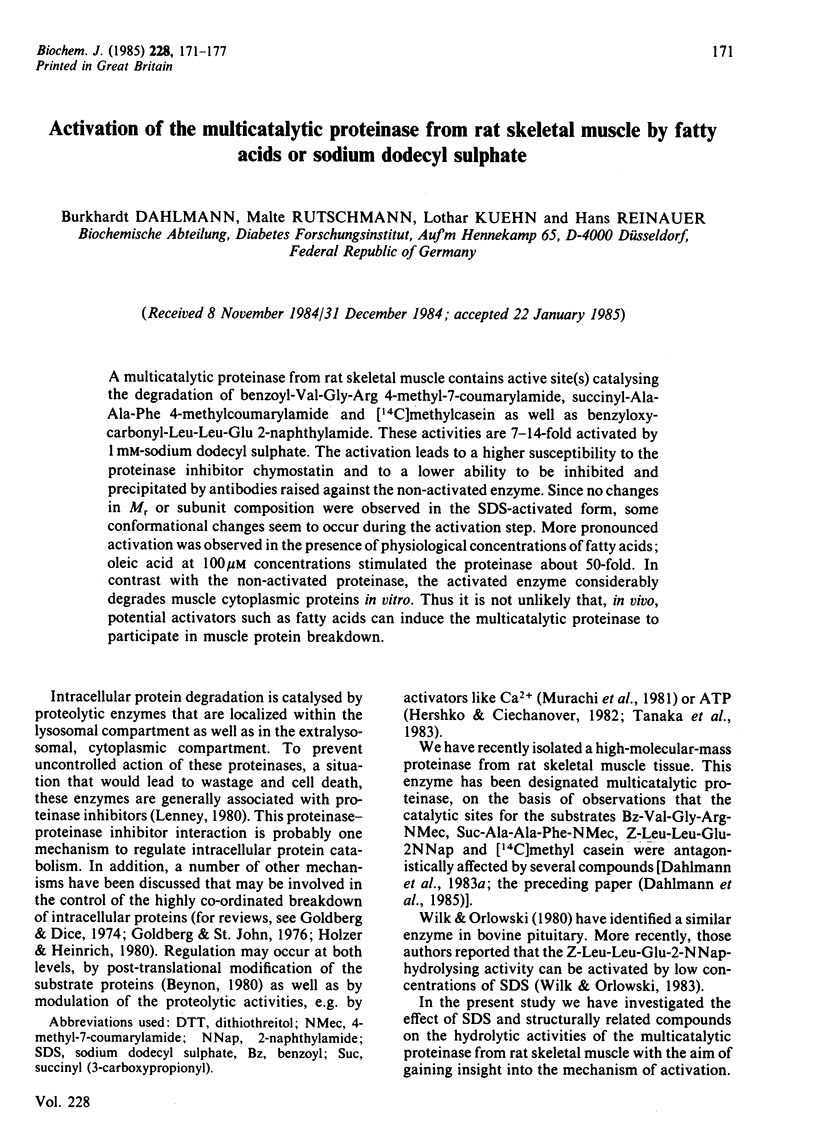
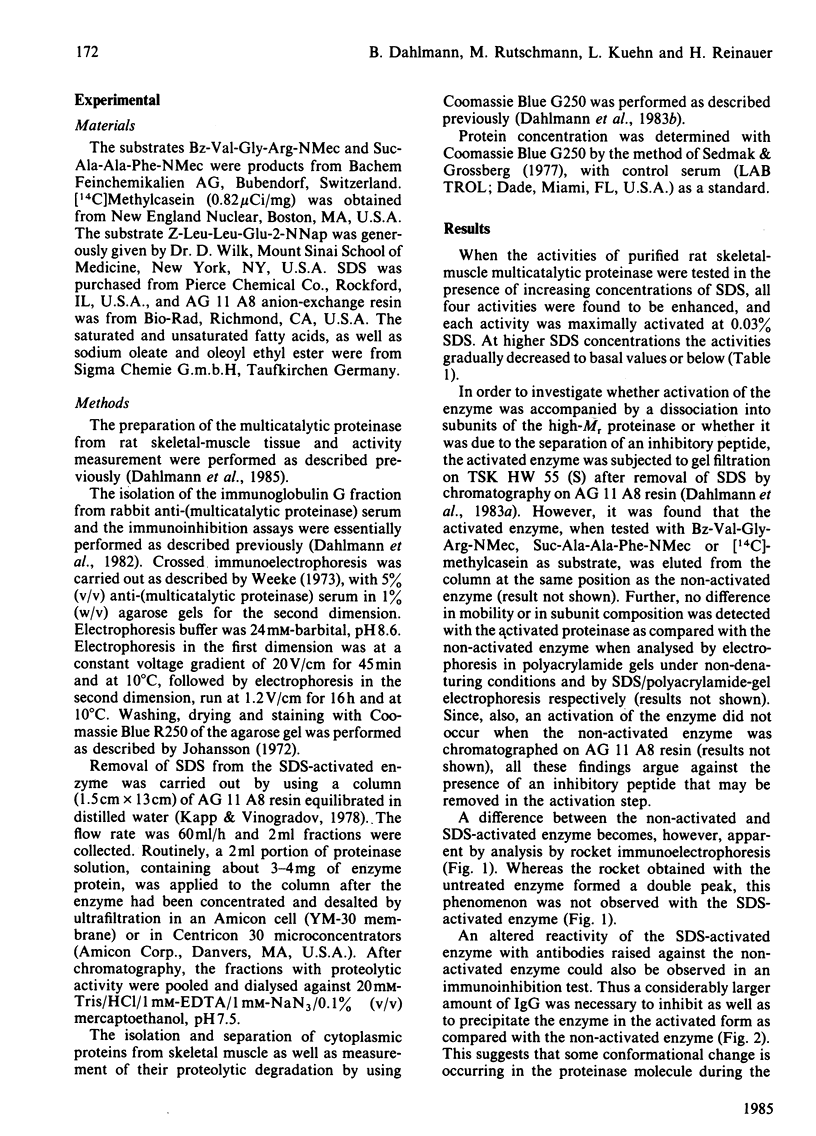
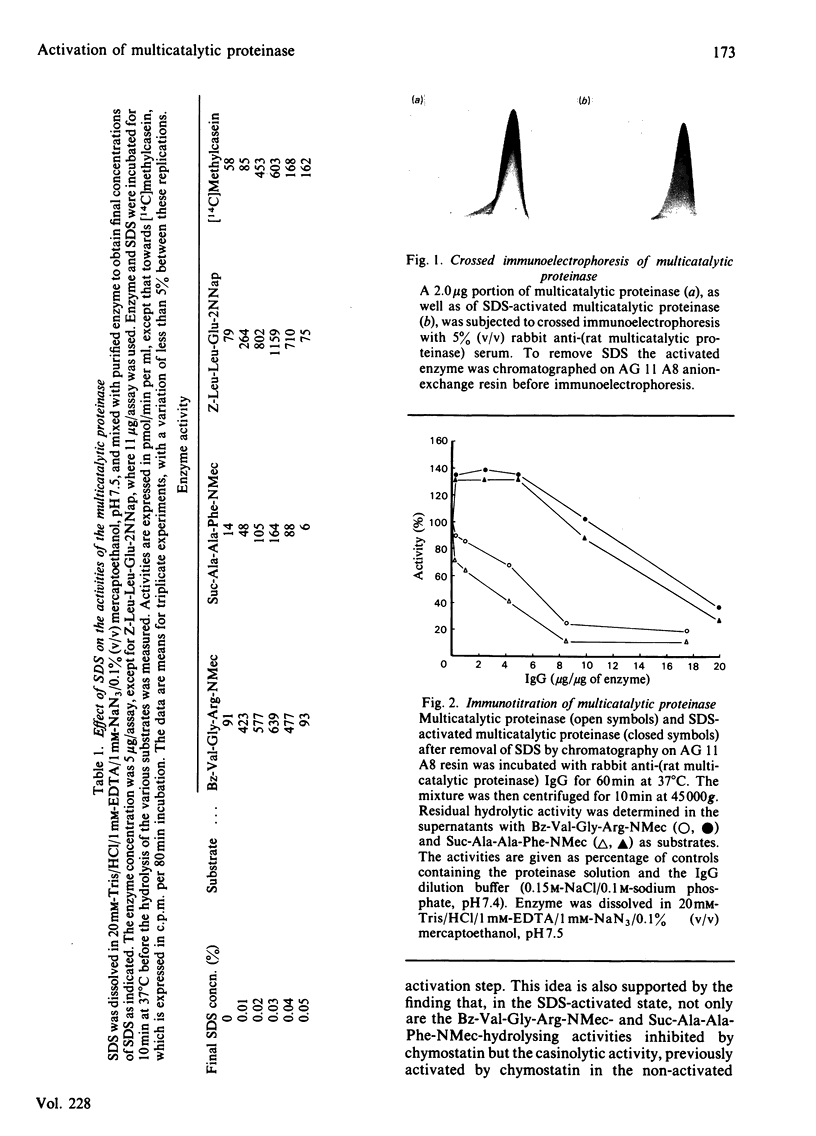
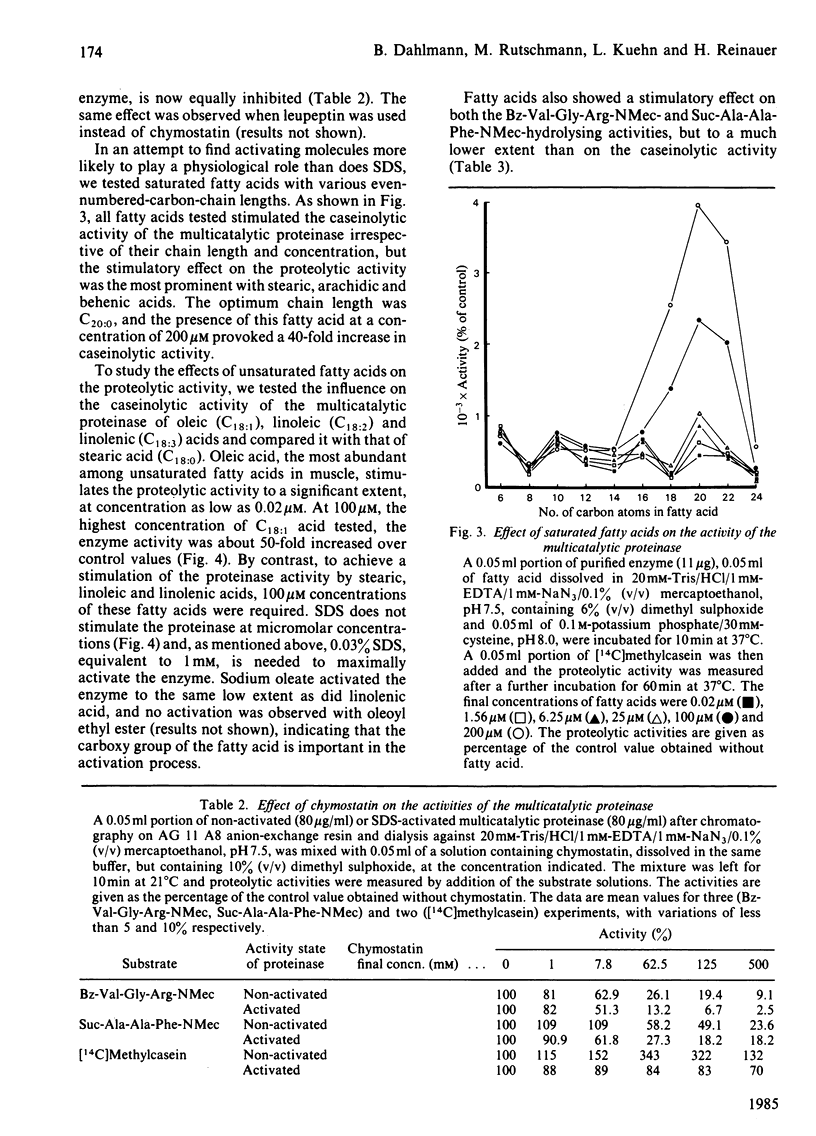
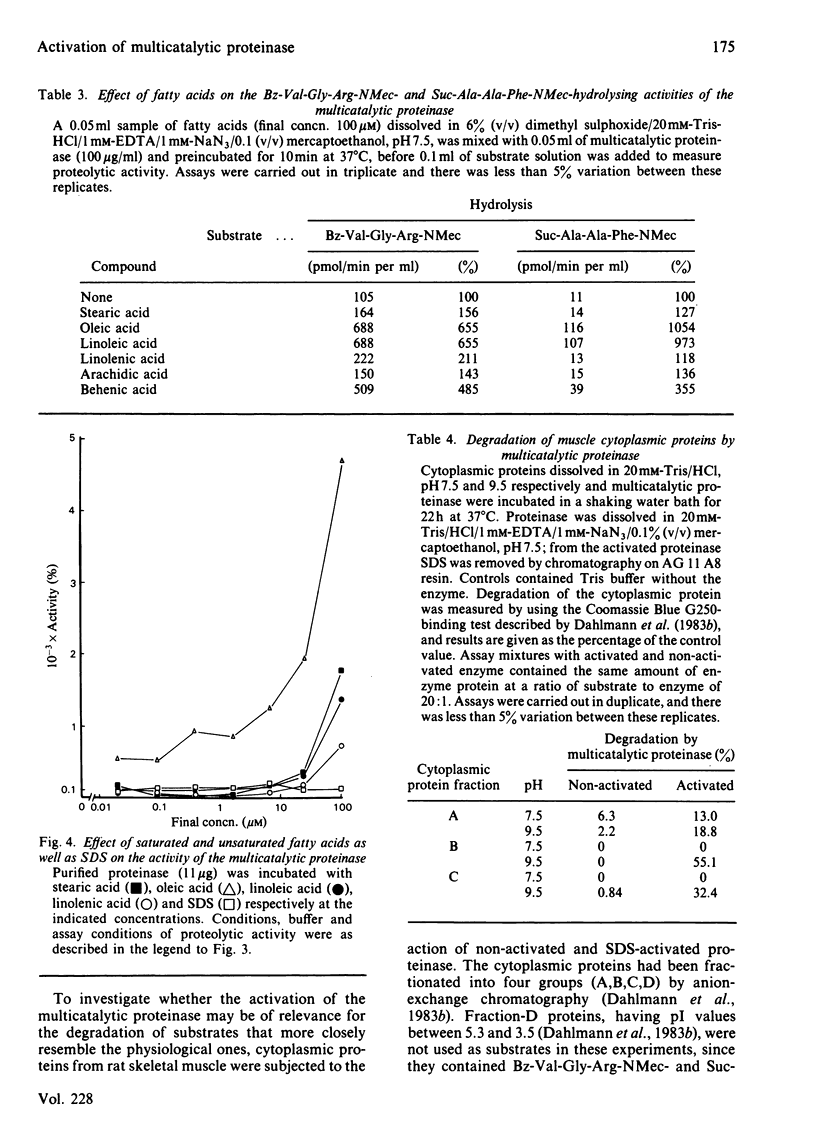
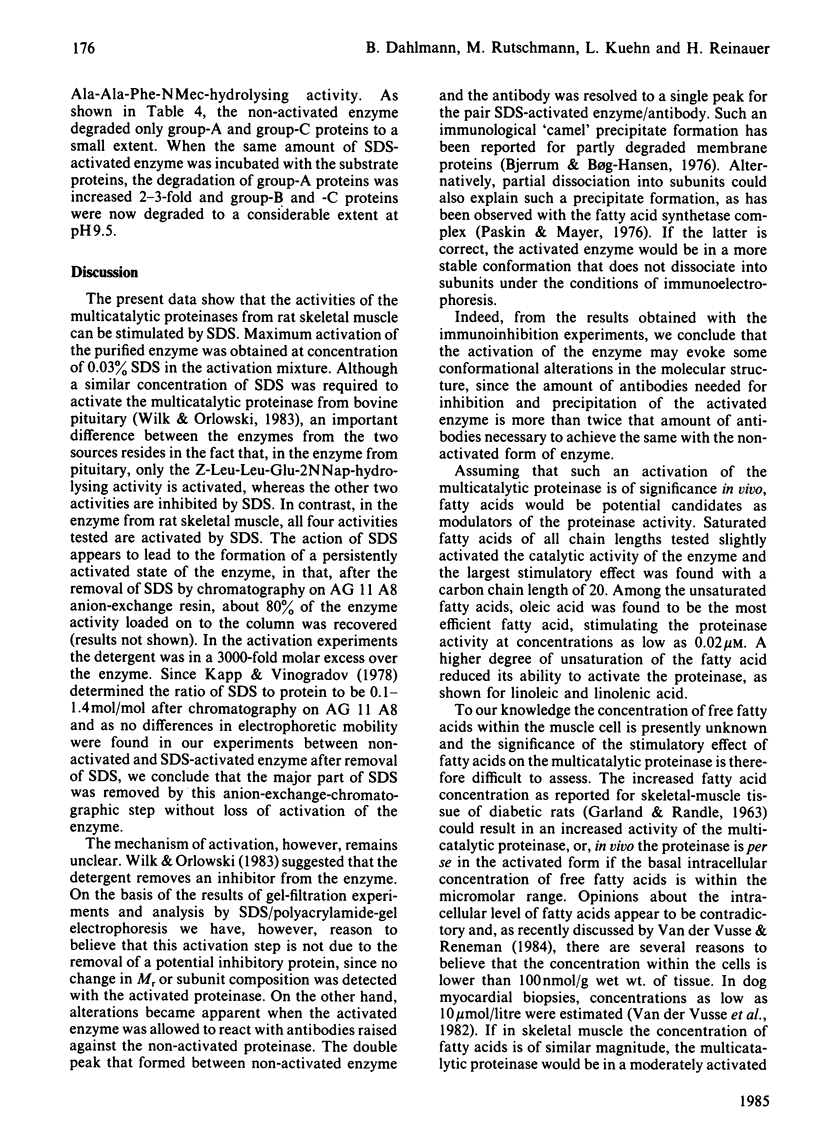
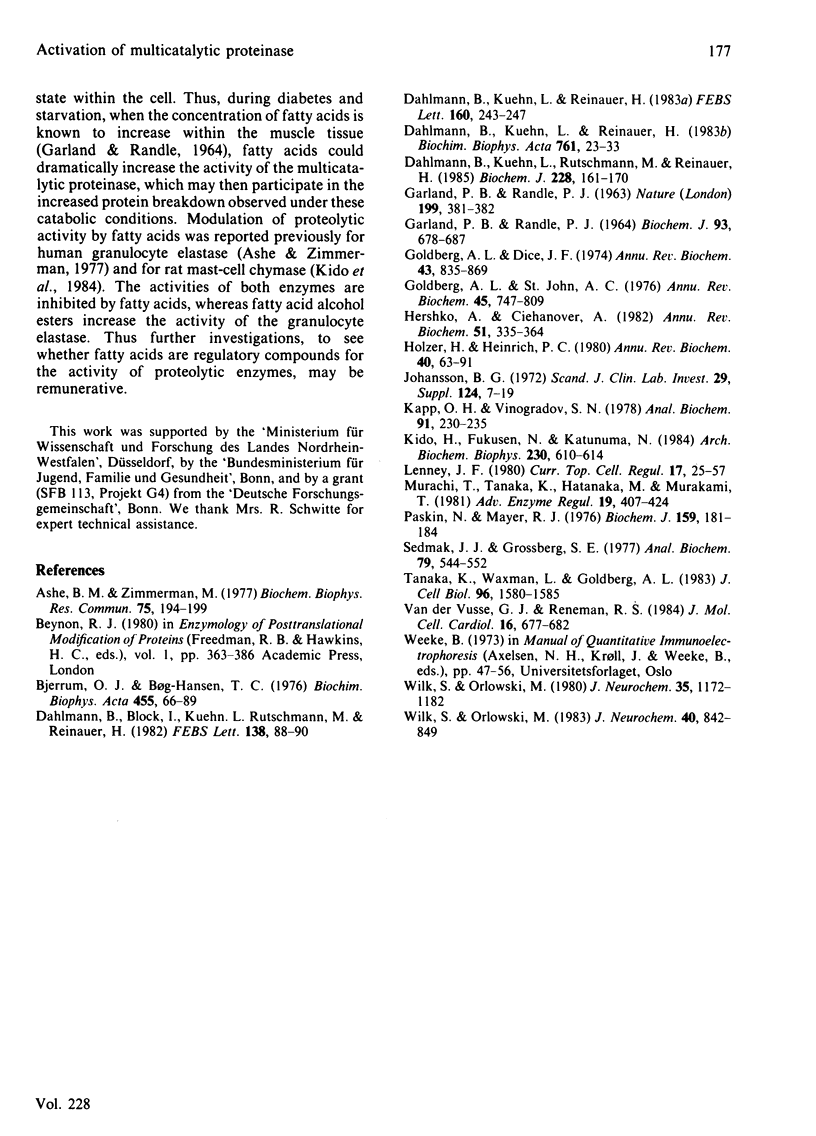
Images in this article
Selected References
These references are in PubMed. This may not be the complete list of references from this article.
- Ashe B. M., Zimmerman M. Specific inhibition of human granulocyte elastase by cis-unsaturated fatty acids and activation by the corresponding alcohols. Biochem Biophys Res Commun. 1977 Mar 7;75(1):194–199. doi: 10.1016/0006-291x(77)91308-0. [DOI] [PubMed] [Google Scholar]
- Bjerrum O. J., Bog-Hansen T. C. The immunochemical approach to the characterization of membrane proteins. Human erythrocyte membrane proteins analysed as a model system. Biochim Biophys Acta. 1976 Nov 11;455(1):66–89. doi: 10.1016/0005-2736(76)90154-1. [DOI] [PubMed] [Google Scholar]
- Dahlmann B., Block I., Kuehn L., Rutschmann M., Reinauer H. Immunological evidence for the identity of three proteinases from rat skeletal muscle. FEBS Lett. 1982 Feb 8;138(1):88–90. doi: 10.1016/0014-5793(82)80401-8. [DOI] [PubMed] [Google Scholar]
- Dahlmann B., Kuehn L., Reinauer H. Identification of three high molecular mass cysteine proteinases from rat skeletal muscle. FEBS Lett. 1983 Aug 22;160(1-2):243–247. doi: 10.1016/0014-5793(83)80975-2. [DOI] [PubMed] [Google Scholar]
- Dahlmann B., Kuehn L., Reinauer H. Susceptibility of muscle soluble proteins to degradation by mast cell chymase. Biochim Biophys Acta. 1983 Nov 22;761(1):23–33. doi: 10.1016/0304-4165(83)90358-6. [DOI] [PubMed] [Google Scholar]
- Dahlmann B., Kuehn L., Rutschmann M., Reinauer H. Purification and characterization of a multicatalytic high-molecular-mass proteinase from rat skeletal muscle. Biochem J. 1985 May 15;228(1):161–170. doi: 10.1042/bj2280161. [DOI] [PMC free article] [PubMed] [Google Scholar]
- GARLAND P. B., RANDLE P. J. EFFECTS OF ALLOXAN DIABETES AND ADRENALINE ON CONCENTRATIONS OF FREE FATTY ACIDS IN RAT HEART AND DIAPHRAGM MUSCLES. Nature. 1963 Jul 27;199:381–382. doi: 10.1038/199381a0. [DOI] [PubMed] [Google Scholar]
- Garland P. B., Randle P. J. Regulation of glucose uptake by muscles. 10. Effects of alloxan-diabetes, starvation, hypophysectomy and adrenalectomy, and of fatty acids, ketone bodies and pyruvate, on the glycerol output and concentrations of free fatty acids, long-chain fatty acyl-coenzyme A, glycerol phosphate and citrate-cycle intermediates in rat heart and diaphragm muscles. Biochem J. 1964 Dec;93(3):678–687. doi: 10.1042/bj0930678. [DOI] [PMC free article] [PubMed] [Google Scholar]
- Goldberg A. L., Dice J. F. Intracellular protein degradation in mammalian and bacterial cells. Annu Rev Biochem. 1974;43(0):835–869. doi: 10.1146/annurev.bi.43.070174.004155. [DOI] [PubMed] [Google Scholar]
- Goldberg A. L., St John A. C. Intracellular protein degradation in mammalian and bacterial cells: Part 2. Annu Rev Biochem. 1976;45:747–803. doi: 10.1146/annurev.bi.45.070176.003531. [DOI] [PubMed] [Google Scholar]
- Hershko A., Ciechanover A. Mechanisms of intracellular protein breakdown. Annu Rev Biochem. 1982;51:335–364. doi: 10.1146/annurev.bi.51.070182.002003. [DOI] [PubMed] [Google Scholar]
- Holzer H., Heinrich P. C. Control of proteolysis. Annu Rev Biochem. 1980;49:63–91. doi: 10.1146/annurev.bi.49.070180.000431. [DOI] [PubMed] [Google Scholar]
- Kapp O. H., Vinogradov S. N. Removal of sodium dodecyl sulfate from proteins. Anal Biochem. 1978 Nov;91(1):230–235. doi: 10.1016/0003-2697(78)90835-7. [DOI] [PubMed] [Google Scholar]
- Kido H., Fukusen N., Katunuma N. Inhibition of chymase activity by long chain fatty acids. Arch Biochem Biophys. 1984 May 1;230(2):610–614. doi: 10.1016/0003-9861(84)90442-9. [DOI] [PubMed] [Google Scholar]
- Lenney J. F. Inhibitors associated with the proteinases of mammalian cells and tissues. Curr Top Cell Regul. 1980;17:25–57. doi: 10.1016/b978-0-12-152817-1.50006-7. [DOI] [PubMed] [Google Scholar]
- Murachi T., Tanaka K., Hatanaka M., Murakami T. Intracellular Ca2+-dependent protease (calpain) and its high-molecular-weight endogenous inhibitor (calpastatin). Adv Enzyme Regul. 1980;19:407–424. doi: 10.1016/0065-2571(81)90026-1. [DOI] [PubMed] [Google Scholar]
- Paskin N., Mayer R. J. Molecular weight and subunit size of fatty acid synthetase from rabbit mammary gland. Biochem J. 1976 Oct 1;159(1):181–184. doi: 10.1042/bj1590181. [DOI] [PMC free article] [PubMed] [Google Scholar]
- Sedmak J. J., Grossberg S. E. A rapid, sensitive, and versatile assay for protein using Coomassie brilliant blue G250. Anal Biochem. 1977 May 1;79(1-2):544–552. doi: 10.1016/0003-2697(77)90428-6. [DOI] [PubMed] [Google Scholar]
- Tanaka K., Waxman L., Goldberg A. L. ATP serves two distinct roles in protein degradation in reticulocytes, one requiring and one independent of ubiquitin. J Cell Biol. 1983 Jun;96(6):1580–1585. doi: 10.1083/jcb.96.6.1580. [DOI] [PMC free article] [PubMed] [Google Scholar]
- Wilk S., Orlowski M. Cation-sensitive neutral endopeptidase: isolation and specificity of the bovine pituitary enzyme. J Neurochem. 1980 Nov;35(5):1172–1182. doi: 10.1111/j.1471-4159.1980.tb07873.x. [DOI] [PubMed] [Google Scholar]
- Wilk S., Orlowski M. Evidence that pituitary cation-sensitive neutral endopeptidase is a multicatalytic protease complex. J Neurochem. 1983 Mar;40(3):842–849. doi: 10.1111/j.1471-4159.1983.tb08056.x. [DOI] [PubMed] [Google Scholar]
- van der Vusse G. J., Reneman R. S. The myocardial non-esterified fatty acid controversy. J Mol Cell Cardiol. 1984 Aug;16(8):677–682. doi: 10.1016/s0022-2828(84)80652-5. [DOI] [PubMed] [Google Scholar]



